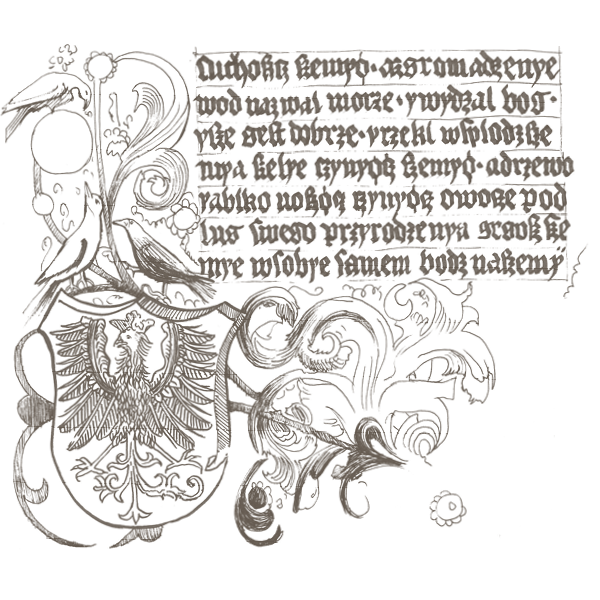In terms of the number of speakers, Polish is the largest West Slavic language.
Language
The Lord's Prayer in Old Polish (13th c.)
Oćcze nasz, jenże jeś na niebiesiech,
oświęci się jimię twe,
przydzi twe krolewstwo,
bądź twa wola jako na niebie tako i na ziemi.
Chleb nasz wszedni
daj nam dzisia
i odpuści nam nasze winy,
jako i my odpuszczamy naszym winowaćcom
i nie wodzi nas w pokuszenie,
ale nas zbaw ode złego.
Polish began to develop as an independent language in the 10th century. The period from the 10th to the 15th century is referred to as Old Polish (język staropolski in Polish), with the first phase until the 12th century being called the pre-literary period (język przedpiśmienny in Polish). Within Polish, the following dialects are distinguished: Greater Polish, Lesser Polish, Silesian, Masovian, and the dialects of the northern and southern Kresy (the former eastern borderlands of Poland).
Script
Polish has used the Latin script since the Middle Ages, and its alphabet today consists of 32 letters. Over time, special characters with diacritical marks (ą, ć, ę, ł, ń, ó, ś, ź, ż) were introduced for certain sounds. A digraph-based orthography developed, meaning some sounds are represented by two letters (sz, rz, ch, dż, dź) and one trigraph (dzi). This system became standardized with the introduction of printing in the 15th century.
The oldest recorded Polish sentence dates back to 1270: "Day, ut ia pobrusa, a ti poziwai" ("Give [me], so that I may grind [the flour], and you rest"). It comes from the so-called Henryków Book (Księga henrykowska, originally Liber fundationis claustri sanctae Mariae Virginis in Heinrichow). This sentence appears in the middle of a Latin text, where the Czech nobleman Bohuchval addresses his Polish wife.
Literature
The earliest literary works created in Polish territory were written in Latin. These primarily include hagiographies (concerning saints such as St. Adalbert, St. Hedwig, St. Kinga, and St. Hyacinth). One notable example is The Life of the Five Martyred Brothers, whose author, Bruno of Querfurt, is known. Historiography also played a significant role, with The Polish Chronicle by Gallus Anonymus from the early 12th century being a key work.
At the turn of the 12th and 13th centuries, Vincent Kadłubek wrote another Polish Chronicle. From the late 13th and early 14th centuries comes The Greater Poland Chronicle (Kronika wielkopolska). At the end of the 14th century, Jan of Czarnków wrote his own chronicle. A major Latin historiographical work was also written by Jan Długosz (1415–1480).
During the 14th century, literature in Polish developed, primarily focusing on religious themes. Translations of biblical texts appeared, especially Psalters, such as The Psalter of St. Kinga (13th century), The Florian Psalter (14th century), and The Puławy Psalter (15th century). A portion of an Old Polish Bible translation has survived in the manuscript of Queen Sophia’s Bible. A popular part of this literature included apocryphal texts like The Life of Jesus and The Life of the Virgin Mary.
The earliest Polish homiletic (preaching) literature can be found in the Gniezno Chapter Manuscript (Kazania gnieźnieńskie) from the late 14th century, which contains 103 Latin sermons and 10 in Polish. Another collection, The Holy Cross Sermons (Kazania świętokrzyskie), dates to the late 13th and early 14th centuries and originated from the Benedictine monastery in Łysa Góra in the Świętokrzyskie Mountains.
The medieval gem of Polish literature is considered to be the Marian knightly hymn "Bogurodzica". While legend attributes its authorship to St. Adalbert (św. Wojciech), it was most likely composed in the 13th or early 14th century. During the Middle Ages, it functioned as a national anthem and was sung during key battles, including the Battle of Grunwald (1410) and the Battle of Varna (1444).
Secular themes began to appear in Polish literature during the 14th and 15th centuries. One example is the poetic treatise "Wiersz o chlebowym stole" (Verse on the Bread Table), written around 1400 by a Cracovian scholar or court member known as Słota.
The 15th century also saw the rise of satirical works, such as Satyra na chytrych kmieciów (Satire on Cunning Landlords), also called Satyra na leniwych chłopów (Satire on Lazy Peasants).
A significant didactic work was Rozmowa mistrza Polikarpa ze Śmiercią (The Dialogue of Master Polikarp with Death), a mid-15th-century dialogue exploring the theme of preparation for a good death (preparatio ad mortem).
Another important piece from this period is the ballad "Wiersz o zabiciu Andrzeja Tęczyńskiego" (Verses on the Killing of Andrzej Tęczyński), written in 1462. This poem recounts the real-life event of July 16, 1461, when Andrzej Tęczyński, the governor of Rabsztyn, was murdered.
Interesting facts
In 1364, the University of Kraków was founded, but it had to be re-established in 1400.
The poem Wiersz o zabiciu Andrzeja Tęczyńskiego (Verses on the Killing of Andrzej Tęczyński) recounts a real event from 1461. Andrzej Tęczyński requested that the Kraków armorer Klemens repair his armor. However, he was dissatisfied with the work and decided to pay far less than the agreed amount. When the craftsman protested, Tęczyński slapped him in his own home.
Tęczyński then filed a complaint at the town hall against Klemens. When the armorer was summoned, Tęczyński left the town hall and encountered the arrested craftsman on the street. According to chronicler Jan Długosz, Klemens shouted at the nobleman: "Sir, you struck and humiliated me in my own home, but you will not hit me again!"
A physical altercation broke out, during which Tęczyński was fatally wounded. News of the incident quickly spread throughout Kraków, and Queen Elisabeth of Austria (Elżbieta Rakuszanka) had to intervene.
External resources:
Digital Library SBC – an archive of scanned texts






